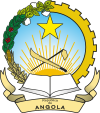Imbangala: Difference between revisions
mNo edit summary |
Idioma-bot (talk | contribs) m robot Adding: lt:Imbangalai |
||
| Line 25: | Line 25: | ||
[[Category:History of Angola]] |
[[Category:History of Angola]] |
||
[[lt:Imbangalai]] |
|||
Revision as of 20:35, 26 January 2010
| Historical states of present-day Angola |
|---|
 |
The Imbangala or Mbangala were 17th century groups of Angolan warriors and marauders who founded the kingdom of Kasanje.
Origins of the Imbangala
The Imbangala were people, possibly from Central Africa, that appeared on the scene in Angola during the early 17th century. The precise origins of the people are still hotly debated. Today, it is generally agreed upon that they were not the same Jagas that attacked the Kingdom of Kongo during the reign of Alvaro I.
In the 1960s, it was proposed that oral traditions of the Lunda Empire suggested that both groups of Jaga marauders originated in the Lunda Empire and had fled it during the 17th century. Another theory is that the Imbangala were actually a local people of southern Angola originating from the Bihe Plateau or the coastal regions the west of the highlands.
The first eyewitness account of the Imbangala, written by an English sailor named Andrew Battell, who lived with them for 16 months in around 1600–1601, places them firmly in the coastal regions and highlands of modern day Angola, just south of the Kwanza River. Their leaders told Battell that they had come from a place called "Elembe" and that they had originated from a "page" in its army. Battell's story was published by Samuel Purchas partially in 1614 and fully in 1625.
Imbangala and the Portuguese
The Portuguese took an interest in the Imbangala about the time that Battell first lived with them. In fact, Battell went to their country in company with Portuguese merchants who were buying up their war captives to sell as slaves. At the time of their contact, the Imbangala were acting as mauraders whose primary interest seemed to be pillage the country, especially in order to obtain large quantities of palm wine, which they produced by a wasteful method of chopping the tree down and tapping out its fermented contents over a period of a few months. In addition, the Imbangala did not permit its female members to give birth, allegedly exposing all the children born in their kilombo (Portuguese quilombo) or armed camp. Instead, they replenished their numbers by capturing adolescents and forcing them to serve in their army. In methods reminiscent of modern day child soldier recruitment, the young captives were often forced to kill and eat people, consumed considerable alcohol, and could not be admitted to full membership until they had killed an enemy in combat. Cannibalism, ritual human sacrifice and torture were all featured in what seventeenth century observers called the "quixilla laws" (from Kimbundu kixila, or prohibition) by which the Imbangala were said to live.
Their military capacity and ruthlessness made them appealing to Portuguese colonists in Angola who had been fought to a standstill in their war against the Angolan kingdom of Ndongo during the first period of colonial rule (1575–1599). Despite professed disgust at their customs, Portuguese governors of Luanda sometimes hired the Imbangala for their campaigns, beginning with Bento Banha Cardoso in 1615, but most notably following Luis Mendes de Vasconcelos's 1618 assault on Ndongo. Mendes de Vasconcelos operated with three distinct bands of Imbangala, but soon found that they were not disciplined to serve the Portuguese. Kasanje's band, in particular, broke free of Portuguese control and began a long campaign of pillage that eventually would establish them in the Baixa de Cassange region of modern Angola along the Kwango River. This band would become the modern Angolan ethnicity that calls itself Imbangala (and ceased the militant customs of its predecessors in the late seventeenth century).
Another band, Kaza, actually joined up with Ndongo and opposed the Portuguese, though it would eventually betray Ndongo's Queen Njinga Mbande in 1629, thus frustrating that queen's attempt to preserve Ndongo's independence from a base on islands in the Kwanza River. After Njinga's short lived attempt to join with Kasanje in 1629-30, she went to Matamba and there formed her own (or joined with another) Imbangala band led by a man known only as "Njinga Mona" (Njinga's son). Though reported to be an Imbangala herself (supposedly taking an initiation rite that involved pounding up a baby in a grain mortar), Njinga probably never really became one.
Later fate
Other bands were integrated into the Portuguese army, serving as auxiliary soldiers, under their own commanders and cantoned within the Portuguese territory. As the seventeenth century wore on, these and other bands were either annihilated by one or another of the political states such as the one formed by Njinga in Matamba. One rogue group of Imbangala actually set down roots and formed the kingdom of Kasanje. South of the Kwanza, however, in the original homeland of the Imbangala, they continued operating much as before for a least another half a century, but even there they gradually formed partnerships with existing political entities such as Bihe (Viye), Huambo (Wambu) or Bailundu (Mbailundu). In all these areas, their customs tended to moderate in the eighteenth century, cannibalism was restricted to ritual and sometimes only to symbolic occasions (for example in the nineteenth century Imbangala groups in the central highlands still practices a ritual know as "eating the old man").
